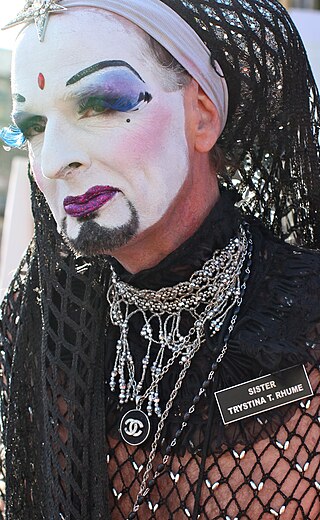
Tomboy is a term used for girls or young women with masculine traits. It can include wearing androgynous or unfeminine clothing and engaging in physical sports or other activities and behaviors usually associated with boys or men.

Early childhood education (ECE), also known as nursery education, is a branch of education theory that relates to the teaching of children from birth up to the age of eight. Traditionally, this is up to the equivalent of third grade. ECE is described as an important period in child development.
Tokenism is the practice of making only a perfunctory or symbolic effort to be inclusive to members of minority groups, especially by recruiting people from underrepresented groups in order to give the appearance of racial or gender equality within a workplace or educational context. The effort of including a token individual in work or school is usually intended to create the impression of social inclusiveness and diversity.

A gender bender is a person who dresses up and presents themselves in a way that defies societal expectations of their gender, especially as the opposite sex. Bending expected gender roles may also be called a genderfuck.
The gender binary is the classification of gender into two distinct forms of masculine and feminine, whether by social system, cultural belief, or both simultaneously. Most cultures use a gender binary, having two genders.
Childhood gender nonconformity (CGN) is a phenomenon in which prepubescent children do not conform to expected gender-related sociological or psychological patterns, or identify with the opposite sex/gender. Typical behavior among those who exhibit the phenomenon includes but is not limited to a propensity to cross-dress, refusal to take part in activities conventionally thought suitable for the gender and the exclusive choice of play-mates of the opposite sex.

William's Doll is a 1972 picture book by Charlotte Zolotow, one of the first children's texts to address nontraditional gender stereotypes. The story follows William, a young boy who wishes for a doll to care for. His father is unhappy with this, instead giving him toys that he considers to be more gender appropriate. Finally, his grandmother fulfills his request, explaining to her son that it will let him practice good parenting.

The feminization of the workplace is the feminization, or the shift in gender roles and sex roles and the incorporation of women into a group or a profession once dominated by men, as it relates to the workplace. It is a set of social theories seeking to explain occupational gender-related discrepancies.
An implicit bias or implicit stereotype is the pre-reflective attribution of particular qualities by an individual to a member of some social out group. Recent studies have determined that "implicit bias" towards those of the opposite gender may be even more influential than racial implicit bias.

Women are often under-represented in the academic and professional fields of engineering; however, many women have contributed to the diverse fields of engineering historically and currently. A number of organizations and programs have been created to understand and overcome this tradition of gender disparity. Some have decried this gender gap, saying that it indicates the absence of potential talent. Though the gender gap as a whole is narrowing, there is still a growing gap with minority women compared to their white counterparts. Gender stereotypes, low rates of female engineering students, and engineering culture are factors that contribute to the current situation where men dominate in fields relating to engineering sciences.

Many scholars and policymakers have noted that the fields of science, technology, engineering, and mathematics (STEM) have remained predominantly male with historically low participation among women since the origins of these fields in the 18th century during the Age of Enlightenment.
Gender roles are culturally influenced stereotypes which create expectations for appropriate behavior for males and females. An understanding of these roles is evident in children as young as age four. Children between 3 and 6 months can form distinctions between male and female faces. By ten months, infants can associate certain objects with females and males, like a hammer with males or scarf with females. Gender roles are influenced by the media, family, the environment, and society. In addition to biological maturation, children develop within a set of gender-specific social and behavioral norms embedded in family structure, natural play patterns, close friendships, and the teeming social jungle of school life. The gender roles encountered in childhood play a large part in shaping an individual's self-concept and influence the way an individual forms relationships later on in life.
Gender roles in non-heterosexual communities are a topic of much debate; some people believe traditional, heterosexual gender roles are often erroneously enforced on non-heterosexual relationships by means of heteronormative culture and attitudes towards these non-conformative relationships.

Gender disparity in computing concerns the disparity between the number of men in the field of computing in relation to the lack of women in the field. Originally, computing was seen as a female occupation. As the field evolved, so too did the demographics, and the gender gap shifted from female dominated to male dominated. The believed need for more diversity and an equal gender gap has led to public policy debates regarding gender equality. Many organizations have sought to create initiatives to bring more women into the field of computing.
Curricula in early childhood care and education (ECCE) or early childhood curriculum address the role and importance of curricula in the education of young children, and is the driving force behind any ECCE programme. It is ‘an integral part of the engine that, together with the energy and motivation of staff, provides the momentum that makes programmes live’. It follows therefore that the quality of a programme is greatly influenced by the quality of its curriculum. In early childhood, these may be programmes for children or parents, including health and nutrition interventions and prenatal programmes, as well as centre-based programmes for children.
Sex differences in education in the United States refers to the specific issues, such as gender-based discrimination related to coursework and use of disciplinary action, that American students of all genders encounter. Furthermore, while sex differences in education explains the prevalence of gender-based differences in education on a global scale, the American education system includes specific forms of gender discrimination dissimilar to other countries.

Gender discrimination in health professions refers to the entire culture of bias against female clinicians, expressed verbally through derogatory and aggressive comments, lower pay and other forms of discriminatory actions from predominantly male peers. These women face difficulties in their work environment as a result of a largely male dominated positions of power within the medical field as well as initial biases presented in the hiring process, but not limited to promotions.

Female education in STEM refers to child and adult female representation in the educational fields of science, technology, engineering, and mathematics (STEM). In 2017, 33% of students in STEM fields were women.
Gender digital divide is defined as gender biases coded into technology products, technology sector, and digital skills education. It can refer to women's lack of access to, use of, and professional development in computing work. The gender digital divide has changed throughout history due to social roles, economics, and educational opportunities.
Early childhood education in the United States relates to the teaching of children from birth up to the age of eight. The education services are delivered via preschools and kindergartens.









